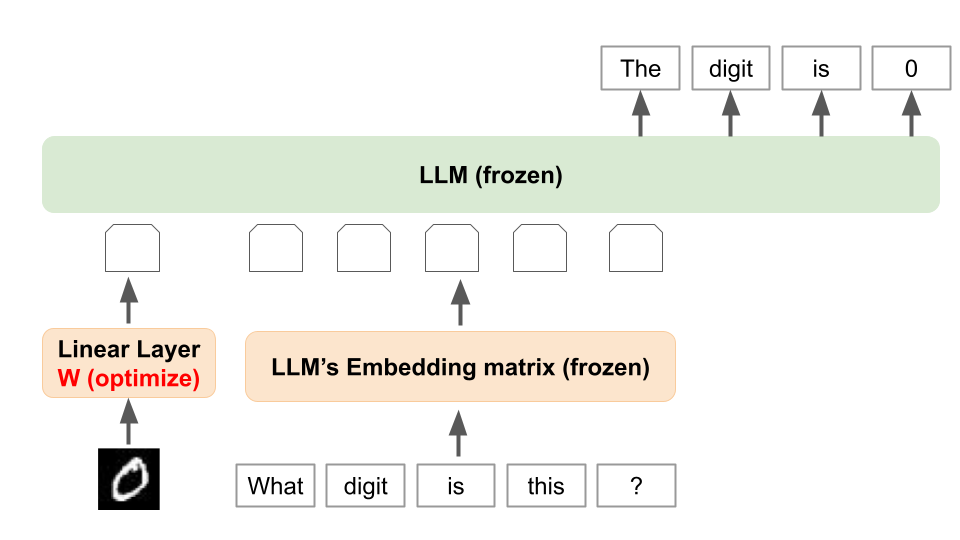Model Card for Llava-mnist
Llava-mnist is a simple example of Vision and Language model using LLaVA architecture trained on MNIST dataset.
You can use this model (just one linear layer vision encoder model) alongside meta-llama/Meta-Llama-3.1-8B-Instruct.
Training Details
The model was trained on the chat-style MNIST dataset, which is structured as follows:
prompt: “<image>What digit is this?”
output: "The digit is {label}."
The Llava-MNIST model transforms the digit image into an embedding vector that resides in the same space as the text token embedding.
The loss function optimized during training is defined as:
$L(W)= -\log P_W(This digit is {label}|<image>What digit is this?)$
During training, the parameters of the Llama 3.1 model are kept frozen, and only the parameters of the vision encoder (Llava-MNIST) are optimized.
How to use
You can input multi-modal data (vision and text) into the Llama 3.1 model by using the Llava-MNIST model as the vision encoder.
from transformers import AutoTokenizer, AutoModelForCausalLM
import torch
from datasets import load_dataset
from torchvision import transforms
import util
from transformers import AutoModel
def build_multi_modal_prompt(
prompt: str,
image: torch.Tensor,
tokenizer: AutoTokenizer,
model: AutoModelForCausalLM,
vision_model: AutoModel,
) -> torch.Tensor:
parts = prompt.split("<image>")
prefix = tokenizer(parts[0])
suffix = tokenizer(parts[1])
prefix_embedding = model.get_input_embeddings()(torch.tensor(prefix["input_ids"]))
suffix_embedding = model.get_input_embeddings()(torch.tensor(suffix["input_ids"]))
image_embedding = vision_model(image).to(torch.bfloat16).to(model.device)
multi_modal_embedding = torch.cat(
[prefix_embedding, image_embedding, suffix_embedding], dim=0
)
return multi_modal_embedding
model_id = "meta-llama/Meta-Llama-3.1-8B-Instruct"
tokenizer = AutoTokenizer.from_pretrained(model_id)
model = AutoModelForCausalLM.from_pretrained(
model_id,
torch_dtype=torch.bfloat16,
device_map="auto",
)
vision_model = AutoModel.from_pretrained(
"speed/llava-mnist", trust_remote_code=True
)
terminators = [
tokenizer.eos_token_id,
tokenizer.convert_tokens_to_ids("<|eot_id|>"),
]
system_prompt = (
"<|begin_of_text|><|start_header_id|>system<|end_header_id|><|eot_id|>"
)
user_prompt = "<|start_header_id|>user<|end_header_id|>"
question = "<image>What digit is this?"
assistant_prompt = "<|start_header_id|>assistant<|end_header_id|>"
prompt = system_prompt + user_prompt + question + assistant_prompt
ds = load_dataset("ylecun/mnist", split="test")
def transform_image(examples):
transform = transforms.Compose(
[
transforms.ToTensor(),
transforms.Normalize((0.1307,), (0.3081,)),
transforms.Lambda(lambda x: torch.flatten(x)),
]
)
examples["pixel_values"] = [transform(image) for image in examples["image"]]
return examples
ds.set_transform(transform = transform_image)
model.eval()
vision_model.eval()
example = ds[0]
input_embeded = util.build_multi_modal_prompt(
prompt, example["pixel_values"].unsqueeze(0), tokenizer, model, vision_model
).unsqueeze(0)
response = model.generate(
inputs_embeds=input_embeded,
max_new_tokens=20,
eos_token_id=terminators,
do_sample=True,
temperature=0.6,
top_p=0.9,
)
response = response[0]
print("Label:", example["label"]) # Label: 7
answer = tokenizer.decode(response, skip_special_tokens=True)
print("Answer:", answer) # Answer: The digit is 7.
References
- Liu et al., LLaVA: Large Language and Vision Assistant, https://llava-vl.github.io/
- Downloads last month
- 6
